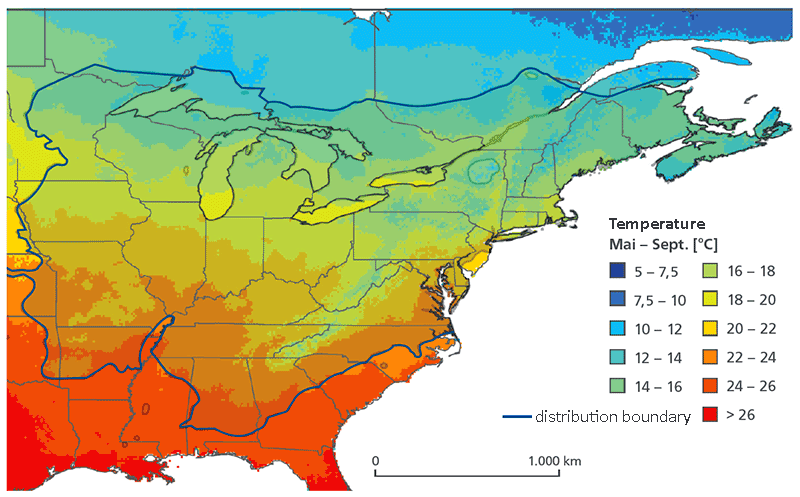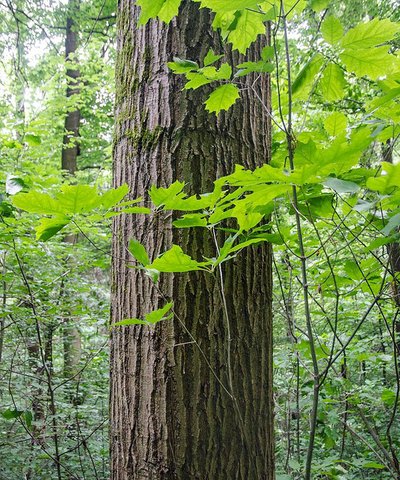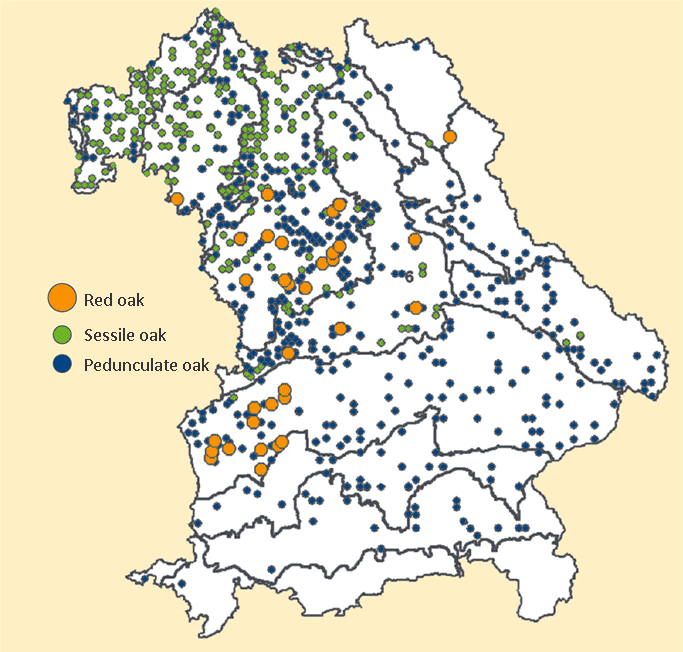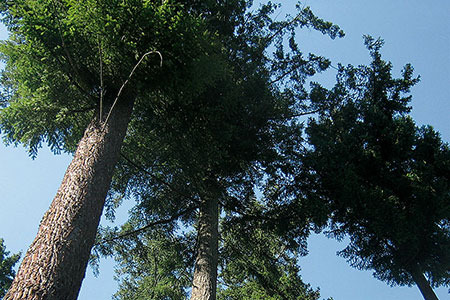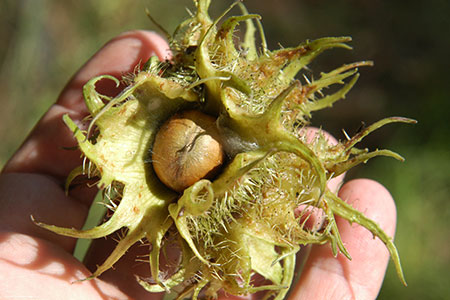The red oak (Quercus rubra), also known as the northern red oak, is a tree species native to eastern North America. It was first brought to Europe more than 400 years ago, and has been grown with varying degrees of success in Germany ever since. There are still gaps in our knowledge of this tree species, due to the limited number of scientifically monitored cultivation trials being carried out.
The red oak in North America
In the natural growth range of the red oak, annual precipitation levels are between 760 mm and 2030 mm, and average annual temperatures vary considerably between 4 °C and 16 °C (Fig. 1). In its indigenous area, the red oak prefers sites on deep soils. It is not a species that thrives on extreme sites. After the American tulip tree (Liriodendron tulipifera), it is the most important deciduous tree in economic terms in its native region, and grows mainly in mixed stands with other broadleaves and northern white pine. The red oak has the following ecological characteristics:
- It is a semi-shade species
- It has prolific sprouting ability
- It has a highly vigorous root system (root depth of 2.8 m possible)
- It has a poor litter decomposition rate
- It thrives on a wide range of different site types
- It displays strong self-differentiation (maintenance of its own lower storey)
- It has a high degree of resistance to pollutants
Experimental areas in Germany
Experimental plots were set up in northern and south-western Germany to gather information on the growth of this species. Growth rates on these plots were observed to be higher for the red oak species than for native oak species.
We can summarise the results for the 17 experimental plots in Baden Württemberg as follows: At 100 years old, the predominant height of the red oaks exceeds that of the native oak species by 11 to 14 metres. The tallest red oaks grow in loess over buntsandstein (coloured sandstone) and in moderately fresh fine loam, in areas with a mean annual temperature of 9.6 °C and annual precipitation above 1000 mm. The native oaks attain similar predominant heights on these sites, but only when considerably older. The same height is reached even at considerably lower levels of precipitation.
In terms of diameter development, the red oak is clearly superior to the "German" oaks. To attain a breast height diameter (BHD) of 50 centimetres, the red oak needed an average of 95 years, whereas the pedunculate oak (Quercus robur) and sessile oak (Quercus petraea or Quercus sessiliflora) needed 150 years. One factor that certainly helps promote the growth of diameter is the early and rigorous intervention on the experimental red oak plots.
In terms of volume increase, the red oaks achieve an increase of 12 cubic metres of standing wood per hectare and year (cbm/ha*a) at 60 years old, whereas native oaks achieve an increase of just around six cbm/ha*a. With regard to the total growth performance, the red oaks achieve around 200 cbm/ha*a more than native oaks at 60 years old, and around 500 cbm/ha*a more at 120 years old.
Similar observations were made on the experimental plots in north-western Germany. On better sites, the red oak’s volume increment at 93 years old was 44 % higher than that of the pedunculate oak, and its overall growth performance was better by 69 %. For the worst sites the performance ratios were similar for the comparison between red oak and sessile oak, albeit at low levels of growth.
More mass, less value
The high gain in mass is however offset by a lower financial yield. At the moment, the demand for red oak timber is relatively low in the timber processing industries. This is partly because red oak does not form tyloses in its pores, which means it is unsuitable for the production of high quality (water-tight) wooden barrels, and secondly, because the timber has rather "busy" grain structure patterns because of its higher radial growth rates. The trunks have a tendency to form cracks, which limits the timber’s suitability for use in veneer production. The net yields attained at a diameter of 60 cm were approximately 30 % less than the yields for native oaks of comparable diameter.
Trials in Bavaria
Data from the first and second national forest inventories (NFI1 and NFI2) is being used to compare Bavarian oaks at the individual tree level. Whereas the sessile oak is concentrated mainly in north-western Bavaria, the pedunculate oak was recorded mainly in southern and south-eastern Bavaria; the red oak is limited to just a few inventory points mainly on the Franconian Keuper plains and Tertiäres Hügelland region in the northern foothills of the Alps (Fig. 3). For the NFI2 inventory in Bavaria, just 81 red oaks at 33 inventory points were selected as sample trees (Table 1).
Red oak | Pedunculate oak | Sessile oak | |
Number of angle-count method samples 4* | 81 | 1546 | 1373 |
Age span (years) | 19 – 154 | 11 – 254 | 9 – 515 |
Mean age | 56 | 100 | 106 |
BHD min – max [mm] | 71 – 846 | 70 – 1290 | 70 – 1,214 |
Mean BHD | 304 | 423 | 363 |
Height min – max [mm] | 8.3 – 37.9 | 5.1 – 39.9 | 5.6 – 40.2 |
Average height | 22.4 | 22.3 | 23.4 |
Table 1: Description of the statistics of the NFI2 for the trees in the “oak” species group for the state of Bavaria * WZP = angle-count method |
All inventory points at which the genus Quercus occurred were linked to site and climate information from the climate research project KLIP 4. Figure 4 shows the distribution of some parameters and the upper and lower quartile limits for the red oak. In the comparison of performance, the native oaks were only considered if their physiographic parameter values were between these limits. This had the effect of considerably reducing the number of datasets for the native oaks. 81 red oaks, 108 pedunculate oaks and 47 sessile oaks were thus included in the comparison.
It became apparent that the red oaks occur at inventory points at which there are considerably higher levels of precipitation during the vegetation period (Fig. 4). In a comparison of the diameter increments of the red oak with those of native oaks, there were significantly greater increases in diameter growth and thus also volume growth for the red oak species. It must thus be assumed that the red oak grows faster than the native oaks, and that higher yields in terms of mass can thus be expected.
The future of the red oak in Bavaria
Because of the scant availability of data, it is unfortunately only possible to make vague predictions for the future of the red oak in Bavaria. It is however possible to state that the red oak, like native species of oak, can generally tolerate higher temperatures than have prevailed up to now in Bavaria. The red oak is equipped to cope with a rise in temperatures such as that predicted in the course of climate change; it can tolerate warmer winters and warmer summers. It reaches its limit when precipitation decreases at the same time. This makes it susceptible on calcareous sites to root rot, for example. A rise in temperature of more than the feared 2 °C per year is likely to cause problems for the red oak.
The bottom line for forestry practice
The red oak is a tree species that can also be expected in Bavaria to produce a higher volume yield than indigenous oak species. Higher volume yields per hectare can be attained in shorter production periods. This is offset by lower expectations in terms of monetary value. However, current market values should not be seen as a reason to suspend the cultivation of red oak. Technological progress can change market trends.
The cultivation of red oak does not require any particular special measures to be implemented. However, the reasons for the failure of past cultivation attempts should be considered. The mixing of native oaks and red oaks has for example proven unsuccessful in the past because of different growth relations. The red oak is not suitable as a species for marginal sites. On average sites however, the red oak is an interesting secondary tree species that can complement and enhance the spectrum of native tree species.

